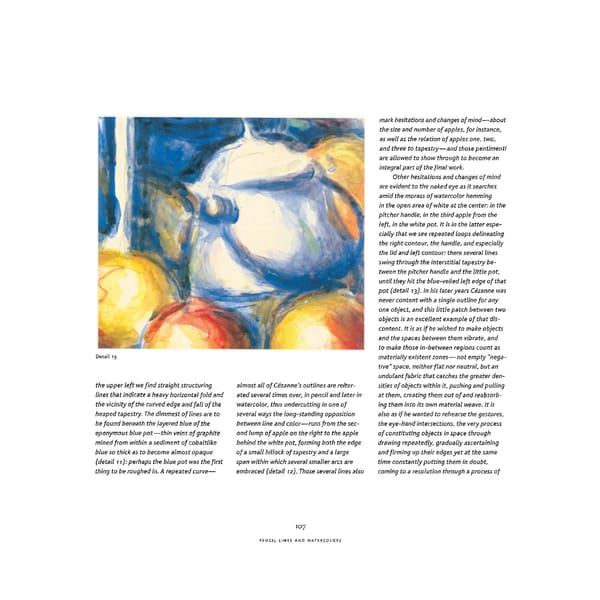mark hesitations and changes of mind—about the size and number of apples, for instance, as well as the relation of apples one, two, and three to tapestry—and those pentimenti are allowed to show through to become an integral part of the final work. Other hesitations and changes of mind are evident to the naked eye as it searches amid the morass ofwatercolor hemming in the open area of white at the center: in the pitcher handle, in the third apple from the left, in the white pot It is in the latter espe- cially that we see repeated loops delineating the right contour, the handle, and especially the lid and left contour: there several lines swing through the interstitial tapestry be- tween the pitcher handle and the little pot, until they hit the blue-veiled left edge of that pot (detail 13). In his later years Cezanne was never content with a single outline for any one object, and this little patch between two objects is an excellent example of that dis- content. It is as if he wished to make objects and the spaces between them vibrate, and to make those in-between regions count as Detail 13 materially existent zones— not empty "nega- tive" space, neither flat nor neutral, but an undulant fabric that catches the greater den- the upper left we find straight structuring almost all of Cezanne's outlines are reiter- sities of objects within it, pushing and pulling lines that indicate a heavy horizontal fold and ated several times over, in pencil and later in at them, creating them out of and reabsorb- the vicinity of the curved edge and fall of the watercolor, thus undercutting in one of ing them into its own material weave. It is heaped tapestry. The dimmest of lines are to several ways the long-standing opposition also as if he wanted to rehearse the gestures, be found beneath the layered blue of the between line and color—runs from the sec- the eye-hand intersections, the very process eponymous blue pot—thin veins of graphite ond lump of apple on the right to the apple of constituting objects in space through mined from within a sediment ofcobaltlike behind the white pot, forming both the edge drawing repeatedly, gradually ascertaining blue so thick as to become almost opaque of a small hillock of tapestry and a large and firming up their edges yet at the same (detail 11): perhaps the blue pot was the first span within which several smaller arcs are time constantly putting them in doubt, thing to be roughed in. A repeated curve— embraced (detail 12). Those several lines also coming to a resolution through a process of 107 PENCIL LINES AND WATERCOLORS
 Cézanne in the Studio: Still Life in Watercolors Page 121 Page 123
Cézanne in the Studio: Still Life in Watercolors Page 121 Page 123